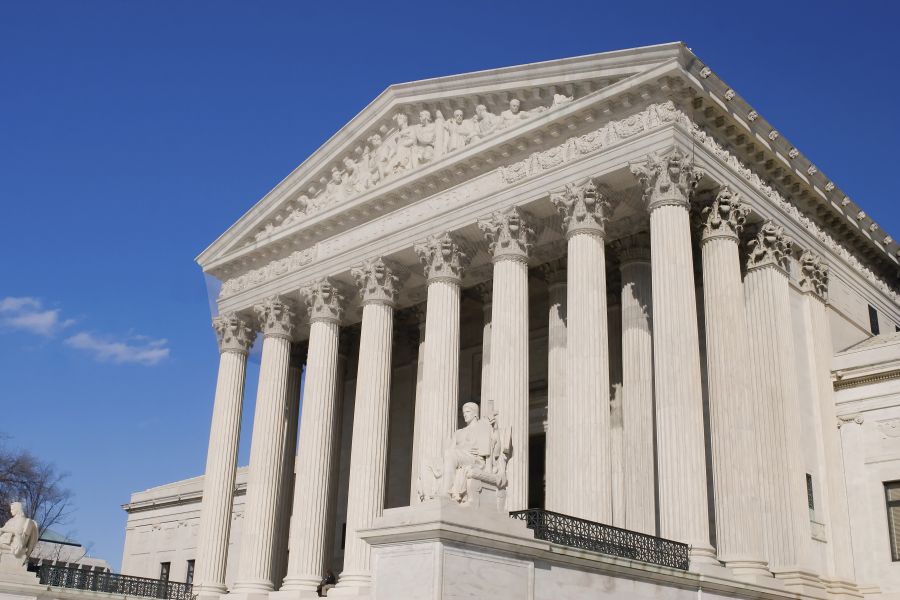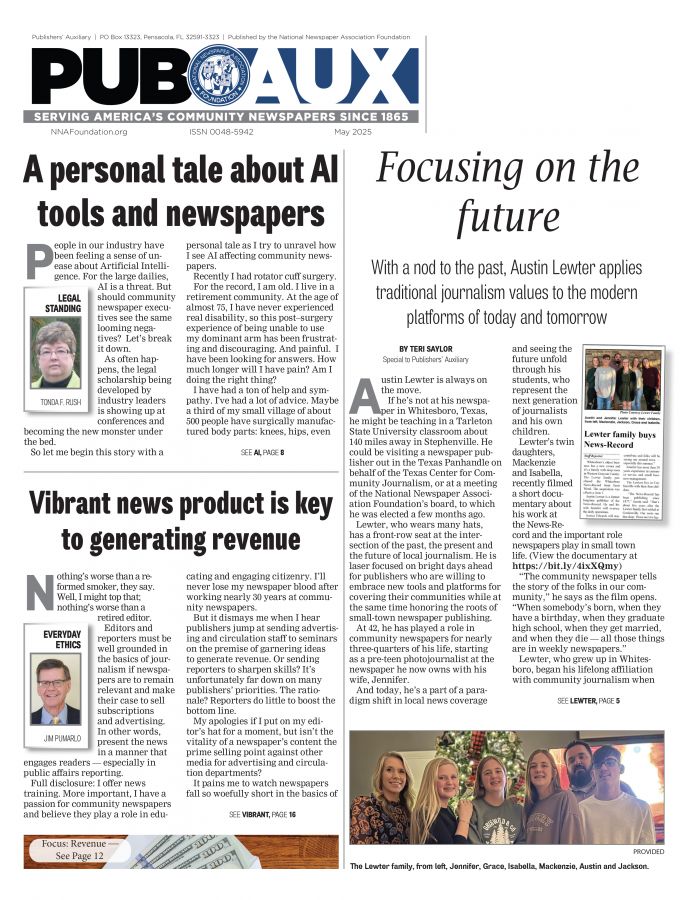With Jay Bender’s help, Murdaugh trial is a lesson in the value of court access
Teri Saylor
Special to Publishers' Auxiliary
Mar 1, 2023


On a balmy day in early February, First Amendment attorney Jay Bender is a jovial figure in a fedora and trench coat as he greets reporters covering an extraordinary murder trial at the Colleton County Courthouse in Walterboro, South Carolina.
Alex Murdaugh, a former partner at The Parker Law Group (formerly Peters Murdaugh Parker Eltzroth and Detrick) is on trial, accused of shooting his son, Paul, with a shotgun at close range and his wife, Maggie, with a powerful rifle. Both sustained multiple gunshot wounds, which killed them instantly.
Bender is the South Carolina Press Association’s general counsel.
He has been spending weeks serving as a liaison between the court and the media for a trial that has become so sensational that it has triggered the imaginations of millions of true-crime fanatics across the globe. That coverage has expanded beyond the local news and spawned a media frenzy, wall-to-wall coverage, and dozens of podcasts and YouTube videos.
In 1993, the South Carolina Supreme Court approved a set of rules concerning courtroom photography. They cover a variety of protocols for handling jury selection, juveniles in the courtroom, lighting, shutter noises and even attire. The judge presiding over any court proceeding must approve the use of cameras in advance.
Bender credits the presiding superior court judge Clifton Newman for drafting rules favoring broad coverage of the Murdaugh trial.
“Judge Newman’s instinct to have the court open and his understanding of the role the press plays in acting as surrogates for the public who can’t be there in person has been key to a process that has gone relatively smoothly,” Bender said.
Courtroom protocol for the Murdaugh trial bans the use of electronics, including laptops, cellphones and even smart watches. Purses and bags must be clear plastic, and everyone enters the courthouse through a security checkpoint. Bender ordered old-school reporter notebooks printed up with a playful message to remind reporters of the rules.
“You have entered the no phone zone. #LeaveItAtHome,” the cover reads, and includes his name and phone number.
The Murdaugh trial started on January 23, and by the second day of proceedings, about 50 media representatives had converged on the smalltown courtroom, with 18 permanent media passes available and four issued by lottery.
In the second week of the trial, a line of spectators from the public eager for a courtroom seat snaked around the courthouse lawn.
“Sometimes I feel like Ticketmaster before a Taylor Swift concert,” Bender quipped.
The journey to this day likely started well before that chilly February night in 2019, when the world first heard about a tragic boat crash at the Archer’s Creek Bridge on Parris Island that killed 19-year-old Mallory Beach and injured several other teenagers. Paul Murdaugh, who allegedly was piloting the boat, was arrested and charged with two counts of boating under the influence causing bodily injury and one count of BUI involving death.
Four years, almost to the day of the boat crash, the plot has thickened like low-country roux and simmered into a gumbo of troubles for Alex Murdaugh — a recipe that includes federal charges for assorted financial crimes totaling at least $9 million, an opioid addiction, a fake suicide attempt, and the murders of Maggie and Paul Murdaugh.
In allocating press passes, Judge Newman prioritized media outlets that have been covering Murdaugh consistently, with local newspapers at the top of the list.
The court order regarding media coverage lists the biweekly Walterboro Press & Standard at the top, followed by Murdaugh’s hometown newspaper, the weekly Hampton County Guardian.
Others receiving daily passes are The Island Packet, The (Columbia) State, The (Charleston) Post & Courier, The Wall Street Journal, the Associated Press, online news provider Fitsnews, the Luna Shark Productions podcast, four local television stations and representatives from national networks FOX, ABC, CBS, NBC and CNN.
Newman selected Court TV as the cameras in courtroom representative to provide televised coverage, with The Post & Courier and The State newspapers providing still photography.
“It’s especially rewarding to see that the local media were given precedent in actually getting the daily passes,” Bender said. “As for the podcasters, the judge recognized that a lot of people get their news that way, so they're part of the mix, and they have access to pool coverage like everyone else.”
The Walterboro Wildlife Center across the street provides a welcoming environment for courtroom overflow with tables and chairs, electricity and Wi-Fi for reporters and members of the public. A large screen is set up for streaming all the courtroom drama as it unfolds. A parking lot next door is home to a herd of local food trucks.
At the end of court each day, reporters have up to 30 minutes to review trial exhibits entered into evidence, and pool photographers provide photographs of the exhibits.
Behind the scenes, Bender monitors public access to evidence and court exhibits. Autopsy photos and images of the murder victims are sealed.
“On the first day of the prosecution's case, law enforcement body-cam video was introduced under seal because it contained graphic images of the bodies,” Bender said.
Court TV is charged with editing any footage the cameras capture to shield the public from the gruesome scene and prevent them from spreading across the internet, Bender said.
“And so, you can't see the bodies lying on the ground,” he added. “Other exhibits include telephone numbers of people not directly involved in the case, and those were redacted before opening them to the public.”
Bender credits Judge Newman for recognizing the value of public access to courts.
“This judge understands in South Carolina we have public trials and a constitutional provision that courts are public,” Bender said. “He also understands that for the public to have confidence in the court system, they must have access to it.”
Inside the Colleton County Courthouse, three video cameras sit in fixed positions. One is on a tripod in a wide aisle between pews facing the judge’s bench and the witness stand. One is mounted on a wall behind the judge, shooting images of the gallery, and the other points toward the defendant’s table. Court TV’s streaming service broadcasts the proceedings in a triptych so people watching from home can view footage from all three angles at the same time.
On this trial day, eight students in the University of South Carolina School of Journalism and Mass Communication and their instructor, Eileen Waddell, are in Walterboro to cover the trial and explore the impact it is having on the small town. A bomb threat that morning forced the court to take an extended break, and Bender used that time to speak with the students about aspects of the case and teach lessons on covering courts.
He predicted that while many reporters will never see trials of this magnitude, they could cover plenty of routine trials and court proceedings. Access is up to the presiding judge.
“If you get into this profession and cover trials, you will need to understand any limitations a particular judge might impose on you,” he told the students.
And Bender warns reporters against aggressively asserting their status as members of the press when it comes to court access.
“Officials who wear black robes understand media privilege somewhat differently, and there are some judges who wouldn't want a camera within a hundred miles of this courthouse,” he said.
For reporters who want to cover court proceedings in their communities, even for the routine proceedings, reporters should read the rules established in their state for court coverage, including using cameras, and begin the process of gaining access well in advance. That process could include communicating with the clerk of court, the presiding judge, law clerk and filling out any required forms.
“Always remember the goal in court is not to make the reporter's life easier,” he said. “The goal is to have a fair trial for the defendant.”
Teri Saylor is a writer in Raleigh, N.C. Reach her at terisaylor@hotmail.com.










